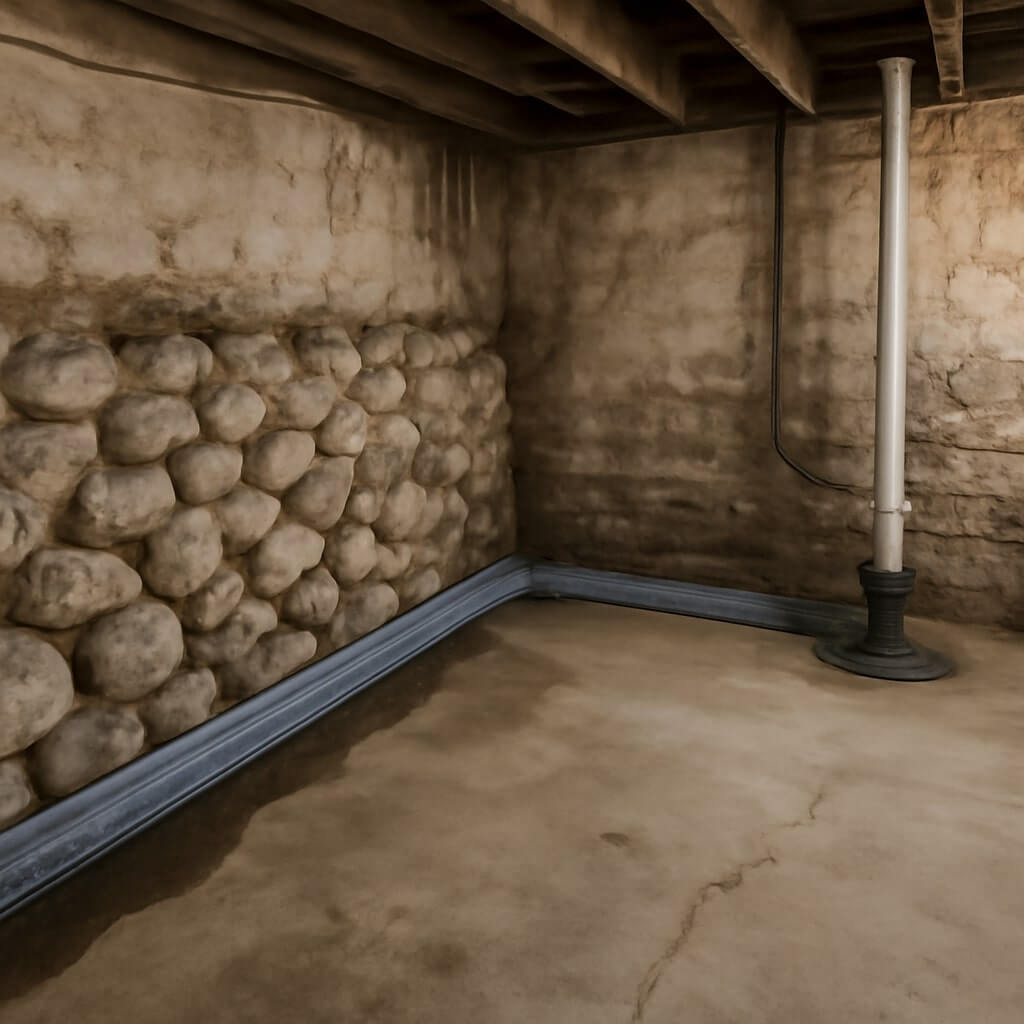When it comes to fieldstone basement waterproofing, many homeowners make essential mistakes that can compromise their efforts. Ignoring proper drainage systems or using the wrong sealing materials can lead to serious water intrusion issues. Additionally, neglecting surface preparation and ventilation needs can exacerbate problems over time. Understanding these common pitfalls is vital for effective waterproofing. Let’s explore these missteps and how you can avoid them for a more resilient basement.
Key Takeaways
- Failing to customize waterproofing solutions for fieldstone basements can lead to inadequate protection against moisture intrusion and damage.
- Neglecting surface cleaning before applying sealants undermines adhesion, resulting in premature seal failure and water leaks.
- Using incompatible or low-quality sealing materials can significantly compromise the effectiveness of waterproofing efforts.
- Overlooking regular inspections for cracks and gaps can allow small issues to escalate into major water intrusion problems.
- Inadequate ventilation in fieldstone basements can trap moisture, increasing the risk of mold growth and structural damage.
Ignoring the Importance of Proper Drainage
One of the most critical factors in effective basement waterproofing is proper drainage.
You need to guarantee that your drainage systems are strategically placed to manage water flow away from your foundation. Neglecting this aspect can lead to water accumulation, causing leaks and structural damage.
Ensure your drainage systems are strategically positioned to direct water away from your foundation, preventing leaks and structural damage.
Install sump pumps and French drains to facilitate ideal water movement. Regularly inspect and maintain these systems to prevent blockages that could impede drainage.
By prioritizing proper drainage, you greatly reduce the risk of water-related issues, protecting your basement and maintaining the integrity of your home.
Don’t underestimate the importance of effective water management.
Using Inappropriate Sealing Materials
Choosing the right sealing materials is essential for effective basement waterproofing, as using inappropriate options can lead to significant problems down the line.
Here are four common mistakes to avoid:
- Using incompatible materials that don’t bond well with your foundation.
- Ignoring the specific sealing techniques recommended for your basement type.
- Selecting low-quality sealants that degrade quickly under moisture exposure.
- Overlooking manufacturer guidelines, which can compromise effectiveness.
Neglecting to Clean the Surface Before Sealing
Even with the right sealing materials, neglecting to clean the surface before sealing can undermine your waterproofing efforts.
Proper surface preparation is essential; dirt, dust, and debris can prevent the sealant from adhering effectively. Before applying any sealing techniques, thoroughly scrub the surface to remove contaminants.
For best results, use a pressure washer or a stiff brush along with a suitable cleaning solution. Allow the surface to dry completely before proceeding with sealing.
Skipping this critical step can lead to premature failure of the seal and potential water intrusion, negating your investment in waterproofing solutions.
Failing to Address Cracks and Gaps
When waterproofing your basement, you can’t overlook small cracks and gaps in the foundation.
Even minor issues can lead to significant water intrusion if left unaddressed.
Make it a priority to inspect and seal these vulnerabilities to guarantee a dry environment.
Ignoring Small Cracks
Small cracks and gaps in your basement might seem insignificant, but neglecting them can lead to major problems over time.
Effective crack detection is essential to maintaining your basement’s integrity. Address these issues promptly using the right repair methods. Here’s what you should know:
- Inspect regularly for new cracks or changes in existing ones.
- Use epoxy or polyurethane injections for small cracks.
- Seal gaps with appropriate caulking to prevent moisture intrusion.
- Monitor humidity levels to reduce the risk of further cracking.
Overlooking Foundation Gaps
Although it may be easy to dismiss foundation gaps as minor issues, overlooking them can lead to significant structural problems in your basement. Regular foundation inspections are essential for identifying these gaps. If left untreated, they can allow moisture and pests to invade your space. Implementing effective gap sealing techniques can prevent future complications.
| Issue | Solution |
|---|---|
| Visible Cracks | Professional Inspection |
| Water Infiltration | Gap Sealing |
| Pest Access | Reinforce Gaps |
Overlooking Ventilation Needs
Neglecting proper ventilation in your basement can lead to significant moisture issues, compromising the effectiveness of any waterproofing efforts.
Proper ventilation in your basement is crucial; neglecting it can cause moisture problems that undermine waterproofing efforts.
To guarantee adequate air circulation, consider these key factors:
- Install ventilation systems that effectively remove humid air.
- Use exhaust fans to help maintain airflow, especially in high-moisture areas.
- Incorporate passive vents to allow natural air exchange.
- Monitor humidity levels regularly to adjust your ventilation strategy as needed.
Skipping Pre-Waterproofing Inspections
Proper ventilation plays an essential role in maintaining a dry basement, but skipping pre-waterproofing inspections can undermine your efforts.
Conducting these inspections offers significant pre-inspection benefits, such as identifying existing moisture issues and potential vulnerabilities. This proactive approach can save you from costly repairs down the line.
While you may hesitate due to inspection costs, the investment is minimal compared to the expenses associated with water damage.
By taking the time for thorough inspections, you guarantee a more effective waterproofing strategy, leading to a healthier, drier basement environment.
Don’t overlook this vital step in your waterproofing process.
Miscalculating the Water Table Levels
When you miscalculate water table levels, you risk implementing ineffective waterproofing solutions that can lead to significant issues in your basement.
Understanding groundwater levels is essential for proper waterproofing. Here are key points to keep in mind:
- Assess Local Water Table: Determine average seasonal fluctuations in your area.
- Soil Composition: Analyze soil types as they affect drainage and water retention.
- Elevation: Reflect on the elevation of your basement relative to the water table.
- Weather Patterns: Monitor rainfall and snowmelt, as they influence groundwater levels.
Taking these factors into account can prevent costly mistakes and protect your basement from water damage.
Rushing the Drying Process
Rushing the drying process in basement waterproofing can lead to significant issues.
Proper curing is essential for ensuring materials bond effectively, while incomplete drying raises the risk of mold and structural damage.
Employing effective drying techniques can mitigate these risks and enhance the longevity of your waterproofing efforts.
Importance of Proper Curing
Curing is a critical phase in the basement waterproofing process, as it directly affects the integrity and effectiveness of the materials used.
Rushing this process can compromise your efforts. Here’s why proper curing matters:
- Cure Time: Allow sufficient time for materials to set properly.
- Moisture Control: Control moisture levels to prevent premature drying.
- Structural Integrity: Guarantee the bond between materials is solid.
- Long-Term Durability: A well-cured system enhances longevity.
Risks of Incomplete Drying
Proper curing sets the foundation for a successful waterproofing project, but the risks of incomplete drying can undermine that effort.
Rushing the drying process can lead to moisture retention, which fosters mold growth and compromises structural integrity. If you don’t allow adequate time for drying, trapped moisture can weaken your waterproofing materials, resulting in costly repairs down the line.
Utilizing improper drying techniques may further exacerbate the issue, leaving your basement vulnerable. Always prioritize thorough drying to guarantee your waterproofing solution is effective and long-lasting.
Taking the time to properly dry can save you significant headaches in the future.
Techniques for Effective Drying
While it might seem tempting to speed up the drying process to move on to the next phase of your basement waterproofing project, doing so can lead to significant setbacks.
Instead, utilize effective drying methods and moisture control techniques to guarantee thorough drying. Consider these steps:
- Ventilation: Increase air circulation using fans or open windows.
- Dehumidification: Employ dehumidifiers to remove excess moisture from the air.
- Heating: Use heaters to raise the temperature and promote evaporation.
- Moisture Monitoring: Regularly check humidity levels to gauge progress.
Taking your time with drying will prevent future complications.
Assuming One Solution Fits All Situations
Many homeowners mistakenly believe that one waterproofing solution can effectively address all basement issues, but this assumption can lead to inadequate protection.
Each basement is unique, requiring customized solutions based on specific conditions such as soil type, water table levels, and foundation design. An individualized assessment is essential to identify the most effective methods for your situation.
Relying on a one-size-fits-all approach can leave you vulnerable to water damage, mold growth, and structural issues. To guarantee long-lasting results, consult professionals who can tailor a waterproofing strategy that meets your basement’s specific needs and challenges.
Conclusion
In conclusion, avoid common mistakes in fieldstone basement waterproofing by prioritizing proper drainage, selecting compatible sealing materials, and thoroughly cleaning surfaces. Address all cracks and gaps, and guarantee adequate ventilation to prevent humidity issues. Don’t skip pre-waterproofing inspections or miscalculate water table levels, and allow sufficient drying time. Remember, a customized approach is essential; one solution won’t fit every situation. By being diligent, you can achieve effective and long-lasting waterproofing for your basement.

